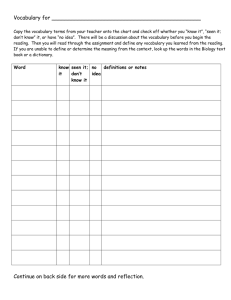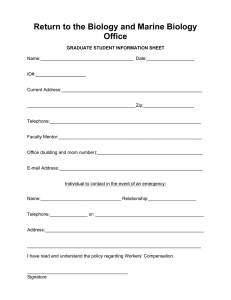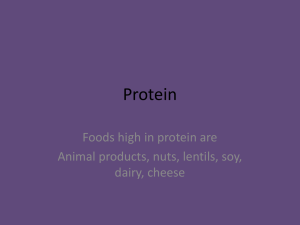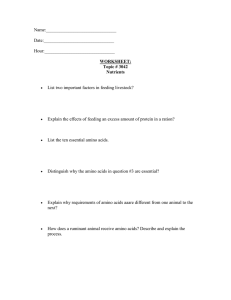Proteins AP Biology 2005-2006
advertisement
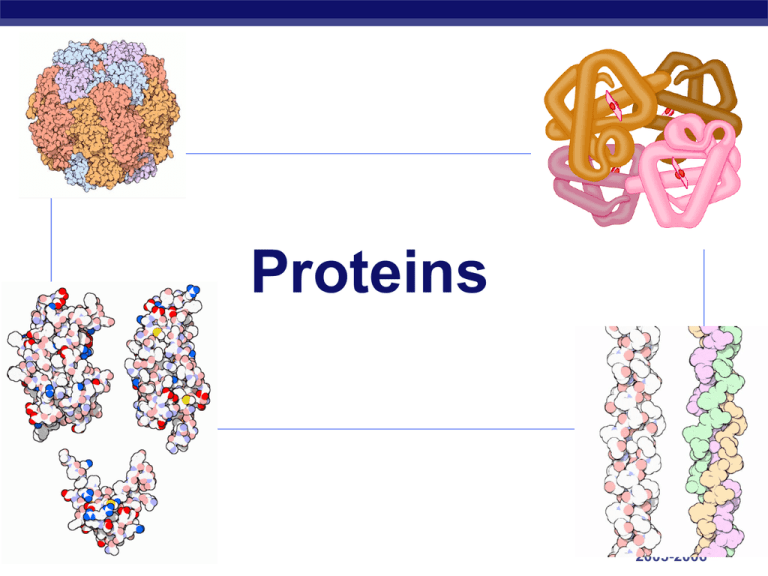
Proteins AP Biology 2005-2006 Proteins Most structurally & functionally diverse group of biomolecules Function: involved in almost everything AP Biology enzymes structure (keratin, collagen) carriers & transport (membrane channels) receptors & binding (defense) contraction (actin & myosin) signaling (hormones) storage (bean seed proteins) Proteins Structure: monomer = amino acids 20 different amino acids polymer = polypeptide protein can be 1 or more polypeptide chains folded & bonded together large & complex molecules complex 3-D shape AP Biology 2005-2006 Amino acids Structure: central carbon amino group carboxyl group (acid) R group (side chain) variable group confers unique chemical properties of the amino acid AP Biology H O H | || —C— C—OH —N— | H R Nonpolar amino acids nonpolar & hydrophobic Why are these nonpolar & hydrophobic? AP Biology 2005-2006 Polar amino acids polar or charged & hydrophilic AP Biology Why are these polar & hydrophillic? 2005-2006 AP Biology 2005-2006 AP Biology 2005-2006 Sulfur containing amino acids Disulfide bridges AP Biology cysteines form cross links 2005-2006 Building proteins Peptide bonds: dehydration synthesis linking NH2 of 1 amino acid to COOH of another C–N bond AP Biology peptide bond 2005-2006 Building proteins Polypeptide chains N-terminal = NH2 end C-terminal = COOH end repeated sequence (N-C-C) is the polypeptide backbone grow in one direction AP Biology 2005-2006 Protein structure & function function depends on structure 3-D structure twisted, folded, coiled into unique shape pepsin hemoglobin AP Biology collagen 2005-2006 Protein structure & function function depends on structure all starts with the order of amino acids what determines that order of amino acids? lysozyme: enzyme in tears & mucus that kills bacteria AP Biology the 10 glycolytic enzymes used to breakdown glucose 2005-2006 to make ATP Primary (1°) structure Order of amino acids in chain amino acid sequence determined by DNA slight change in amino acid sequence can affect protein’s structure & it’s function even just one amino acid change can make all the difference! AP Biology 2005-2006 Sickle cell anemia AP Biology Secondary (2°) structure “Local folding” Folding along short sections of polypeptide interaction between adjacent amino acids -helix -pleated sheet AP Biology 2005-2006 Secondary (2°) structure The Alpha Helix AP Biology Beta-Pleated Sheets 18 Representations of Protein Secondary Structure lysozyme 19 Tertiary (3°) structure “Whole molecule folding” determined by interactions between R groups hydrophobic interactions effect of water in cell anchored by disulfide bridges (H & ionic bonds) AP Biology Quaternary (4°) structure Joins together more than 1 polypeptide chain only then is it a functional protein collagen = skin & tendons hemoglobin AP Biology Protein structure (review) R groups hydrophobic interactions, disulfide bridges 3° multiple polypeptides hydrophobic interactions 1° aa sequence peptide bonds determined by DNA AP Biology 2° R groups H bonds 4° 2005-2006 Chaperonin proteins Guide protein folding AP Biology provide shelter for folding polypeptides keep the new protein segregated from cytoplasmic influences 2005-2006 Protein models Protein structure visualized by X-ray crystallography extrapolating from amino acid sequence computer modelling lysozyme AP Biology Denature a protein Disrupt 3° structure pH salt temperature unravel or denature protein disrupts H bonds, ionic bonds & disulfide bridges Some proteins can return to their functional shape after denaturation, many cannot AP Biology 2005-2006 Let’s build some Insulin! AP Biology The insulin protein has two chains, with a total of 53 amino acids AP Biology The two chains are connected by disulfide bridges from cysteine molecules After you link together the primary sequence through dehydration synthesis, you can join the cysteines together! Each side of the room will build an insulin molecule The abbreviations for the 20 amino acids are found in the table The amino acids are color coded by side group: non-polar, polar, acidic, and basic Water molecules need to be removed by dehydration synthesis Join the amino acids together, then work on the cysteines (part of tertiary structure) Ribosome Animations of Protein Synthesis Real Time Slo-mo Older – Gumby-Like Shows secondary structure of ribosome in action Bonus Question (1st group to answer gets candy) Some of the 20 amino acids are missing from insulin – name them all!


